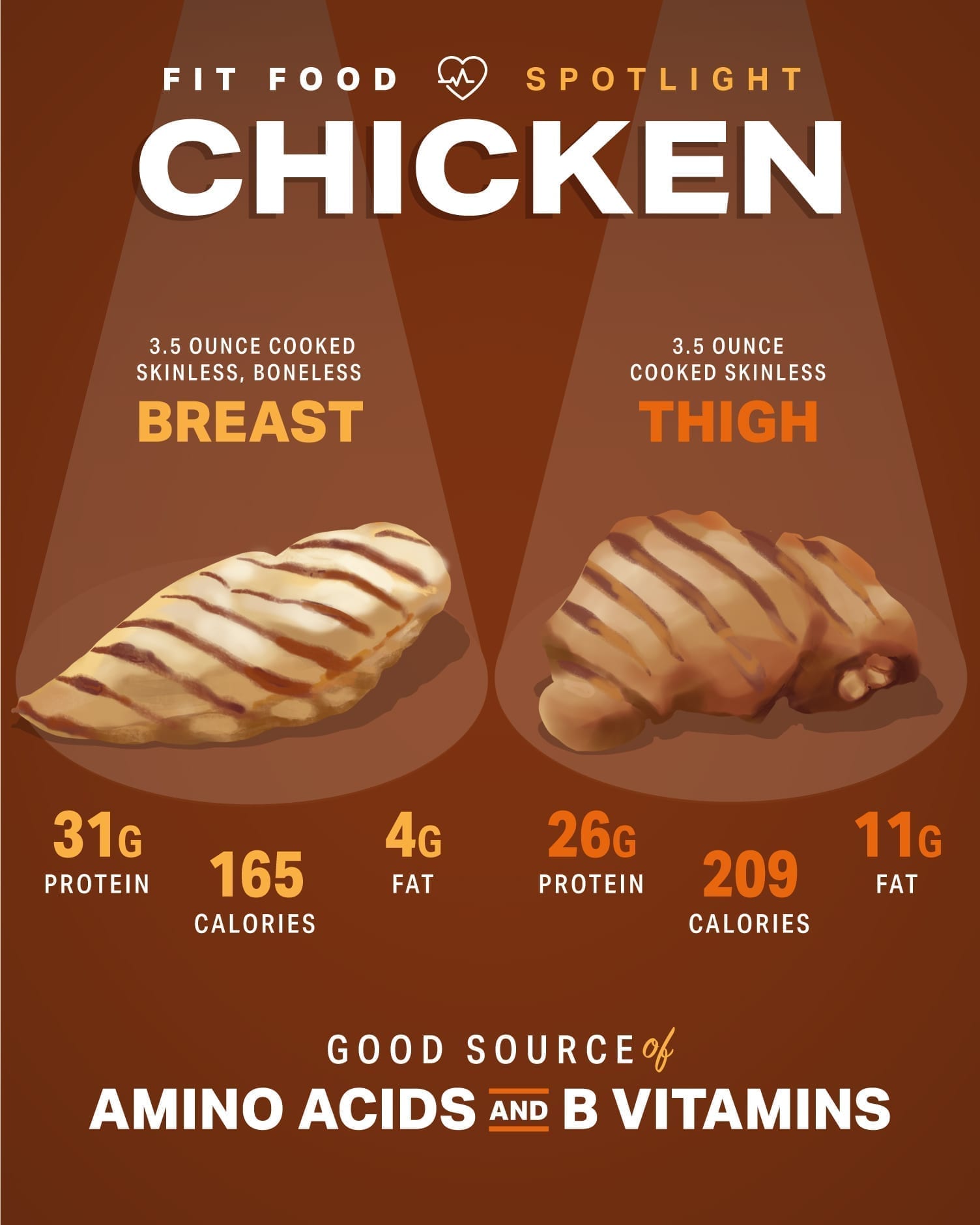
Fitness food explores the properties of a food that make it beneficial for not just your general health, but also your performance plate. Chicken might not be classified as a trendy superfood, but this popular protein can be part of a diet that helps you become lean, fast and strong.


Like all animal proteins, chicken is a complete protein source that also supplies fat and B vitamins while not supplying any carbohydrates or fiber. Each 3.5 ounce (100g) serving of chicken breast meat contains about 31 grams of lean, carb-free protein — with roughly 80% of calories from protein and 20% from fat.
Most adults should aim for 25–35 grams of protein at each meal making chicken an easy option to toss onto your salad, sandwich or stir-fried veggies for a complete meal. Consuming chicken after a workout can replenish muscles with the amino acids needed to rebuild and recover. High-protein diets have been linked to lean-muscle gains. In fact, chicken consumption was shown to be just as effective as beef and whey isolate in improving body composition in men and women.

Like all animal proteins, chicken is a complete protein source, meaning it supplies all essential amino acids in one serving. What is unique to chicken is the high content of branch chain amino acids (BCAAs). BCAAs are three amino acids that must be obtained from the diet or supplementation as your body cannot synthesize them. These particular amino acids have been shown to assist with muscle building. They have also been associated with decreased muscle breakdown, increased muscle recovery and reduced impact of the dreaded DOMS (delayed onset muscle soreness).
Each serving of chicken happens to contain the standard supplemental dose: 100 grams (3.5 ounces) of chicken contains 650mg leucine, 470mg of valine and 375mg isoleucine, while a typical BCAA supplement contains 500mg of leucine, 250mg valine and 250mg isoleucine. Arginine is another amino acid supplied in chicken meat. This amino acid is frequently taken by athletes as a potential performance enhancer due to its role in the metabolic pathways associated with growth hormone, nitric oxide and creatine.

Chicken tends to be a gateway animal protein. Saying something ‘tastes like chicken’ is a ubiquitous term to describe something as tasting pretty neutral. This mild flavor means you can put chicken in just about anything — grilled in salads, simmered in soups, shredded into tacos, diced into grain bowls, roasted with vegetables, fried over waffles and enjoyed at barbecues. Basically, any recipe from any food culture can be made with chicken. Its ease and versatility make it an ideal ingredient for athletes looking to spend less time on food choices and more time fueling their bodies well.
WHITE MEAT OR DARK?
How much of these nutrients (along with how many calories) are supplied varies greatly depending on what part of the chicken is being consumed. A 3.5-ounce serving of cooked chicken breast contains roughly 165 calories, with 80% of that coming from protein and 20% from fat. While chicken thighs, known commonly as ‘dark meat,’ contain 229 calories, less protein and more fat for the same portion. There was a time this fattier piece was thought to be a dietary indulgence, meant only for those not concerned with health. Health-focused people were expected to only consume the leaner, cleaner breast meat.
While this is a good strategy for those looking to increase dietary protein while keeping calories controlled, it is not the only, or even the best, option for a healthy diet. Dark meat cuts such as thighs and drumsticks have nutrients including vitamins B2,3 and 6, which are needed to convert consumed food into ATP for use in athletic training. The extra fat can also help keep athletes satisfied for long endurance workouts or simply resist cravings between mealtimes. These pieces are also cheaper than chicken breast, making dark meat ideal for adhering to a food budget. An easy way to include chicken is to grab a rotisserie bird from the grocer, shred it and pull from it for days. However, these grab-and-go options tend to be injected with extra fat and sodium to boost flavor and juiciness and might not be the most nutritious. Regardless of what piece of the bird is your favorite, choosing a pasture-raised bird is key as these free-roaming birds tend to have more vitamin A, E and omega 3’s — all nutrients that benefit an active body.
THE BOTTOM LINE
Performance foods do not have to be trendy or expensive. Chicken is an accessible, well-tolerated and versatile source of protein that also has nutrients to promote energy usage. For a health-forward approach to this ingredient, purchase pasture-raised birds, watch your portion sizes and don’t be afraid to eat the dark meat.



